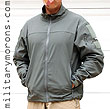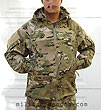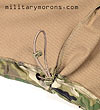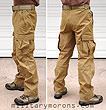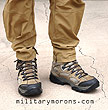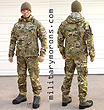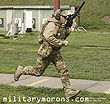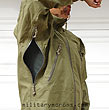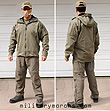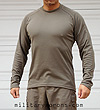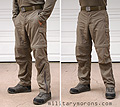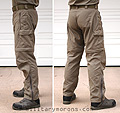Military Clothing (Non Uniform) Page
1 2
3
4 5
7 8 9
This section features Military clothing that are not uniforms/BDUs.
As a sizing reference: I'm 5'7", 155 lbs (yeah, I'm a little guy), medium build (BDU top medium/regular, BDU pant medium/short), waist 32", chest 43". Keep this in mind when you read my comments with respect to sizing, so you have an idea of how the garments featured below will fit on you. ALL garments in these pages are size Medium, unless stated otherwise.
TO VIEW FULL SIZE IMAGES: USERNAME and PASSWORD are both "mm"
| 6/15/09 - OTTE Gear has introduced a new softshell, called the DK Jacket. Designed for movement-intensive operations and activities, it's a hoodless softshell that includes the ability to roll up the sleeves to convert it to short-sleeved configuration. The DK is not just a hoodless version of OTTE's Alpine Jacket, but a completely different cut. Material - The DK jacket comes in two fabric weights. Both are made of Tweave Durastretch fabric, which is a technical stretch woven with 91% nylon and 9% spandex for the shell/face material. It is a durable, abrasion resistant, water and wind resistant, low-bulk, breathable fabric with excellent stretch and recovery properties. The Multi-directional (4-way) permanent-stretch spandex has 100% memory for shape retention. The standard DK Jacket (pictured here) utilizes this non-lined Tweave (same as the Alpine Trouser) and is meant for warmer weather. The DK Jacket Heavy (not pictured here) is the same material as the Alpine Jacket reviewed below. Here's a summary of the features on the DK Jacket soft shell, size medium in Foliage shown:
Convertible sleeves - Now, here's the more unusual feature that the DK Jacket has to offer - it converts to a short sleeve. Not the same way convertible pants go from long to short by removing the pant leg, but by rolling up the sleeves and securing them. Sewn inside the sleeve is an elastic strap with hook velcro on the end, that stows through a slot in the inside of the shoulder pocket when not in use. With the pit zips open, the user draws his wrists back out from the cuffs and sticks his arms out of the pit zips instead. The sleeve is now rolled up on the outside, the elastic strap brought out, and velcro'd to one of the sleeve pocket velcro patches. The height of the rolled up sleeve can be varied by where the strap end is velcro'd - on the upper or lower patch. This feature was designed into the DK at the request of end users who wanted a quick way to vent and cool off excess heat without having to remove the jacket from under all their gear. When wearing plate carriers or body armour, venting out the front zipper isn't possible, so the arms were the only other place that would work. More on this later.
Sizing, fit etc - Shown here is the Medium size.
OTTE Gear soft shells have a slightly more generous fit than similar
jackets made by TAD Gear or Arc'Teryx. The DK jacket will accommodate
a medium weight base layer under it. Like the Alpine Jacket, it's
a very comfortable fit (on my build - 155 lbs, 5' 7") that's
not too snug nor loose, and without excess material so it fits under
rigs or body armour. Notes and Observations - The DK Jacket is light weight, highly water and wind-resistant and easily packable, being an unlined shell. It's also suitable for warmer temperatures than the Alpine Jacket. The huge 20" pit zips allow for quite a bit of ventilation, but of course, I was interested in trying out the short-sleeve feature. Rolling up and securing the sleeves is very straightforward. I was able to roll up both sleeves and secure them without taking the jacket off. To make the roll neater, I made sure that the velcro cuff adjustment tab was at its maximum adjustment so it wouldn't bunch up the cuff. When the elastic strap is secured to the lower velcro patch on the outside of the sleeve, the sleeve isn't rolled up as high, and access to the sleeve pocket is possible. However, I felt that it was too floppy in that configuration and when I'd move my arm up and down it'd be moving the rolled up sleeve around. The elastic strap was too long as well, and would be better at least 2" shorter so it holds the roll tighter. I then rolled up the sleeve a bit more, and secured the strap to the top of the upper velcro patch. This ended up being my preferred configuration as it got the sleeve up higher, and out of the way more. The strap could still be shorter, even in that position. The caveat to rolling it higher is that the sleeve pockets are partially rolled up as well, and aren't very accessible. However, if the user is planning on rolling up the sleeves, I'd recommend leaving them empty, or with only very lightweight items inside just to reduce 'floppage' or and bulk. Rolling up the sleeves with the pit zips open all the way releases a lot of heat - it works as advertised. MM Mod - I started to brainstorm and think about alternatives to just shortening the elastic strap. If I was going to roll the sleeves up, they might as well be all the way for maximum ventilation and the least interference. I found that rolling the sleeves up to the inside was possible, and it was also the 'cleanest' configuration. I added a strap (all I had was webbing, no elastic), sewn to the inside seam at the shoulder, which secured the rolled up sleeve. It looks a bit funky, but no more so than the original configuration. It's almost converts the jacket into a vest. Plus, it's less prone to snagging or coming undone. I've given this feedback to OTTE gear and it's up to them to decide whether they'd like to implement this additional strap as an option and also shorten the original strap.
|
| 5/17/08 - This is something a lot of people have been waiting for (I, for one) - a MultiCam Soft Shell. It's been a couple of years since I saw the prototype at the 2006 SHOT show in OTTE Gear's booth, and it's finally available now. OTTE's Soft Shell line is called the Alpine line (their hard shell/Patrol Parka is in the writeup below). Featured here is OTTE Gear's Alpine Jacket, in Crye MultiCam. It's also available in Black, Coyote and Foliage Green. A matching softshell pant is also available. Material - The OTTE Alpine Jacket is made of Tweave Durastretch fabric, which is a technical stretch woven with 91% nylon and 9% spandex for the shell/face material. It is a durable, abrasion resistant, water and wind resistant, low-bulk, breathable fabric with excellent stretch and recovery properties. The Multi-directional (4-way) permanent-stretch spandex has 100% memory for shape retention. It's laminated to a light lofting knit for some insulation. The moisture-wicking lining material is 90% polyester and 10% X-static fiber, which is a pure silver bonded to the surface of a textile fabric. The X-Static fiber is antimicrobial, which helps inhibit bacterial and fungal growth in the garment, reducing odor. It's also advertised to have excellent thermodynamic (temperature regulating) and moisture transfer properties that keep you "warm in winter and cool in summer" (not necessarily on the same garment, though). It eliminates static charges as well. Editor's note 7-25-09:
The Alpine Jacket with this fabric (X-static and nanosphere) is no
longer in production, and the fabric has been swapped for a lighter
weight stretch woven with DWR for the newer Alpine Jackets. It is
not lined with X-Static fabric. I have not seen this material. Only
the DK Jacket Heavy will be available in the Tweave with X-Static.
Contact OTTE directly for details if you're unsure of what you're
getting. Here's a summary of the features on the Alpine Jacket soft shell, size medium shown:
Sizing, fit etc - Shown here is the Medium size,
and as I mentioned before it's a very comfortable fit (on my build
- 155 lbs, 5' 7") that's not too snug nor loose, and without
excess material so it fits under rigs or body armour. The shape of
the rear panels that are sewn together to make up the jacket are a
bit unusual - instead of a single piece of material to form the back,
or two with a horizontal seam, there's a middle panel and two side
ones that follow the shape of the shoulder blades (and also make up
the sleeves). I can't feel the seams under a pack or rig, so that's
not a concern. The sleeves also have flat panels under the armpits,
for comfort and mobility. General - The lining with X-Static feels very comfortable against bare skin and provides some insulation by relying on reflection of the body's heat back to it, rather than by trapping warm air like with a fleece layer. I also found it to be very breathable. Since it has less insulation than some fleece-lined softshells, it's comfortable up through the mid 70's, wearing just a t-shirt underneath for relaxed activities. The Alpine jacket was originally designed for movement-intensive operations in cool conditions but the comfort range will depend on the level of exertion and conditions. |
| 6/3/08 - These are OTTE Gear's matching soft shell trouser to the Alpine Jacket featured above. Well, in a different colour, obviously. The OTTE Gear Alpine Trouser is a lightweight, breathable and weather resistant soft shell pant. It's also available in Black, Crye MultiCam and Foliage Green. Material - The OTTE Alpine Trouser is made of the same Tweave Durastretch fabric as the Jacket, but is unlined (no X-static lining material). In general, the legs require less insulation than the body under the same conditions since they don't generate as much heat or moisture and have less effect on your core temperature. Durastretch is a technical stretch woven with 91% nylon and 9% spandex for the shell/face material. It is a durable, abrasion resistant, water and wind resistant, low-bulk, breathable fabric with excellent stretch and recovery properties. The Multi-directional (4-way) permanent-stretch spandex has 100% memory for shape retention. It's the same fabric as that used on my Arc'teryx Bravo pants, with the addition of NanoSphere DWR coating (more on that below). Here's a summary of the features on the Alpine Trouser soft shell, medium size shown:
Sizing, fit etc - Shown here is the Medium size,
which has a regular length inseam of 32". I normally wear medium-short,
with a 30" inseam, but I found that the Alpine Trousers weren't
too long for me. Normally, 32" inseam pants cuffs will touch
the ground nead my heels, but the Alpine Trouser cuff diameter is
narrow enough that it doesn't allow the cuff to fall below all the
way to the bottom of the heel. Works for me. If the cuff is tightened
around my boot, it eliminates the issue. The pant cut is very comfortable
and unrestricitve. The stretch nature of the Tweave plays its part
in adding to the range of motion as it stretches. |
OTTE Gear Alpine Trouser (MultiCam)
| 12/26/08 - This is another item that I've been waiting for: OTTE Gear's matching soft shell trousers to the Alpine Jacket featured above, in Crye MultiCam. The OTTE Gear Alpine Trouser is a lightweight, breathable and weather resistant soft shell pant. It's also available in Black, Lt Coyote (shown above), Sand and Foliage Green. The MultiCam Alpine trouser shares the same features as the Lt. Coyote one featured above, which are reiterated here, but with a couple of small differences (the Lt. Coyote one was an early production version): Material - The Alpine Trouser is made of the same Tweave Durastretch fabric as the Jacket, but is unlined (no X-static lining material). In general, the legs require less insulation than the body under the same conditions since they don't generate as much heat or moisture and have less effect on your core temperature. Durastretch is a technical stretch woven with 91% nylon and 9% spandex for the shell/face material. It is a durable, abrasion resistant, water and wind resistant, low-bulk, breathable fabric with excellent stretch and recovery properties. The Multi-directional (4-way) permanent-stretch spandex has 100% memory for shape retention. The MultiCam pattern printing on the Tweave is extremely nice, both in colour and quality. Here's a summary of the features on the Alpine Trouser soft shell, medium size shown:
Sizing, fit etc - Shown here is the Medium size,
which has a regular length inseam of 32". I normally wear medium-short,
with a 30" inseam, but I found that the Alpine Trousers weren't
too long for me. Normally, 32" inseam pants cuffs will touch
the ground nead my heels, but the Alpine Trouser cuff diameter is
narrow enough that it doesn't allow the cuff to fall below all the
way to the bottom of the heel. Works for me. If the cuff is tightened
around my boot, it eliminates the issue. The pant cut is very comfortable
and unrestricitve. The stretch nature of the Tweave plays its part
in adding to the range of motion as it stretches. I did notice that
the MultiCam pant seems to have a slightly higher rise than the Coyote
pant, and fit a bit tighter at the waist. I couldn't see any difference
in the measurement, so it might have been stronger elastic in the
MultiCam pants that gave me that impression. At a recent range session, the weather varied from chilly to 'okay', with rain on and off. I wore the Alpine trousers and they kept me dry when it did rain, and were comfortable throughout the session. I did get mud on the knees when I went to the kneeling position, but when the mud dried, it flaked right off, leaving no trace. |
| 5/20/07 - I met Todd Fairbairn of Ops-Technical Gear at the 2005 SHOT Show. He had some interesting stuff on display - softshells, hardshells etc. At the 2006 SHOT Show, he was sporting a MultiCam hardshell that everyone was drooling over. Since then, he has renamed the company OTTE Gear. 'Otte' was Todd's grandfather's last name. Todd chose to honour his grandfather (who was a soldier, and had no sons) and keep his name alive by naming his company after him. OTTE gear's goal is to provide lightweight, packable and durable clothing for troops and civilians alike for harsh use. Featured here is OTTE Gear's Patrol Parka, in Crye MultiCam. A matching hardshell pant is also available. Material - A note about hardshell MultiCam material. Ever since Crye Precision introduced the MultiCam pattern, we've been waiting for Gore to produce MultiCam GoreTex fabric, or an equivalent hardshell material. However, that project has yet to come to fruition. Crye does not (at the time of this writing), and has not, produced or marketed waterproof hardshell fabric for production use. Bradford Dye, who produces some of the MultiCam fabric for Crye, has printed small quantities of 70D taslan nylon. While the 70D fabric has not yet been tested and officially approved by Crye for its IR properties, Bradford does use the correct dyes to the IR spec. It is this 70D nylon that OTTE purchased and laminated to produce 3-layer hardshell material. The fabric shown is MultiCam 70D Taslan nylon laminated to a PU (Polyurethane) film, as opposed to PTFE film, with a DWR finish on the face . The result is a waterproof/breathable 3-layer fabric very similar in look and feel to GoreTex XCR, but with a slightly softer hand. OTTE Gear will also be experimenting with some PTFE films as well. PU film laminates are in wide use by the outdoor gear industry. Here's a summary of the features on the Patrol Parka Hardshell:
Sizing - I got the Medium size, and there's more than enough room to wear the Patrol Parka over insulated layers. It'll fit over the bulky SPEAR fleece jacket without a problem. There's enough length and room for full mobility and range of motion without the jacket or sleeves riding up, but it doesn't feel or look oversized when worn by itself. As far as 'breathability' goes, I found the Patrol Parka one of the more comfortable, less 'stuffy'-feeling hard shells. Also, while the fabric doesn't seem any thinner than XCR, it's not as stiff. It's my guess that the Patrol Parka can be used in slightly warmer temperatures or climates than garments made out of Goretex XCR or classic. This review will be updated when I get some rain. Updated 8/26/07 - Just got the first rain of the season - we had light to medium rain and it was a bit muggy, but I spent about an hour walking around the neighbourhood with the Patrol Parka. It kept me completely dry underneath, as expected, but the thing that struck me most was the comfort. Usually it feels a bit humid under rain gear but the OTTE Patrol Parka didn't feel stuffy at all. I'd have to rate this as the most 'breathable' hardshell jacket I've tried so far. Very promising. Updated 1/06/08 - I tested it out in very heavy rain the day before, and also at the range the next day. It performed admirably in the rain - no wet throughs or anything. The next days was damp, and the temperature was around 60°. Running around, it got a bit warm and stuffy, but this was even without a jacket. When the temp got a bit colder, it was very comfortable and more importantly kept me dry from the wet ground when shooting from prone. |
OTTE Gear Patrol Parka (Earth)
| 11/15/07 - Here's a look at OTTE Gear's Hardline Patrol Parka in Earth Colour. It differs from the MultiCam Patrol Parka above in both material and of course, colour. All other features and dimensions are the same. Material - During the time the MultiCam Patrol Parka was reviewed, OTTE Gear was experimenting with PTFE membranes besides the PU membrane that was featured above. Since then, OTTE has chosen Donaldson Tetratex® PTFE laminate for all their Patrol Parkas. Donaldson’s PTFE laminate is found in current Military waterproof breathable jackets. It is beefier and slightly more durable than the PU film laminate used on the MC Parka, but slightly stiffer. That was the first thing I noticed when I handled the Earth Patrol Parka. According to OTTE, It was a trade off, but some of the operators in the field wanted the beefier fabric for when they are rolling around on the rocky ground. It will perform like classic Gore-tex; not quite as breathable as Gore-Tex XCR but many users probably won't notice the difference. Donaldson also puts a thicker coating of DWR (Durable Water Repellant) on the fabric that softens up with use. For detailed features of the Patrol Parka (Earth) Hardshell, please see the above review of the MultiCam Patrol Parka.
The "Earth" colour is a bit difficult to pin down; the shade is a bit more on the green side than brown, sort of like Eagle's khaki, but not as yellow. It goes well with most nylon gear, as seen above with an OD MAXPEDITION mini rollypoly, an EMDOM MultiCam Recon Waist Pack, and BH camel tan (khaki) pouch. It goes particularly well with Crye MultiCam as it matches some of the shades in MC very closely. As far as the inital 'stiffness' of the material, Todd was correct - it softens up with wear. Because the material is beefier than the MC PU material, this parka can be used in cooler/colder temperatures that Gore-Tex "classic" garments would be used in. |
| 1/24/08 - For over a decade, Beyond Clothing (formerly separate sites - Beyond Fleece and Beyond Tactical) has been a supplier of high-end custom made cold-weather fleece and soft shells for the outdoor/mountaineering community. With the launch of their new website in May 2007 and a move from Oregon to Seattle, WA, Scott Jones and the Beyond crew now offer an entire line of custom cold weather clothing, from base layers to insulated and wet weather garments. They also integrated their Tactical line into the Beyond Clothing site. Camber Layering System - In July 2007, Beyond was announced as the official manufacturer and supplier of the U.S. Special Operations Command (SOCOM) Custom PCU Cold Weather Layering System. This is based on the current PCU (Protective Combat Uniform) system, but integrated with Beyond's custom manufacturing and fit system, their garments and PCU-specific fabrics and materials. The Beyond PCU - Customization System (PCU-CS) includes 26 integrated garments and is officially available to those members of Special Operations Forces (SOF) who do not fit into the standard grades of the original PCU kit. For anyone who is not an SOF soldier, Beyond has developed the Camber Layering System, from which the garments here are featured. The Camber Layering System parallels and overlaps all the different levels in the PCU-CS. The PCU-CS served as the basis for the Camber, and the main difference between the two systems is that PCU-CS is restricted to govt-specified PCU-specific materials, whereas with the Camber system, Beyond is pretty much unrestricted in their fabric/material choices, being a commercial line. Custom Fit System - What sets Beyond apart is their Custom Fit system. All garments are made to order through their website. Each garment has different options like colours, fabrics and features. You supply your measurements and pick the features you want, and Beyond will build the garment for you. What you get is a perfectly fitting garment with the options of your choice from their available menu for each garment. It's important to provide accurate skin measurements and not to compensate for a snugger or baggier fit in your measurements. Your preference in fit can be specified and Beyond will adjust the fit of the garment accordingly. For example, if you want a more relaxed fit at the waist for those big dinners, provide your correct waist measurement then later specify you want a looser waist or an inch (or whatever) added, and they'll take care of it. It's not complicated, and Beyond's website walks you through the entire process with clear instructions. It's also helpful to get someone to help with some of the measurements. Why bother with a custom fit? Well, some people don't fit into most off-the-shelf garments perfectly; one or two dimensions might be off at times. I'm lucky to be an average, medium size, and most off-the shelf garments fit me just fine. However, I have a shorter torso and jackets will sometimes end up being too long. I also have shorter legs, and wear medium-short. More often than not, I'll have to get the legs shortened. With Beyond's Custom Fit, you'll get a garment that fits you perfectly without having to get it altered and the wasted time and hassle. If for some reason the garment still doesn't fit right, Beyond has a 100% Right-fit guarrantee and will take it back and remedy it provided it's returned within 14 days of receiving it. Base Line Long Sleeve top - The Beyond Base Line Long Sleeve is a wicking layer made from a medium thickness synthetic, Sorbtek (data sheet here). Desert Khaki is sheown here. Sorbtek is stretchy, very lightweight for its thickness, and very comfortable. It provides moisture management by wicking away moisture 4 times faster than channeled polyester fabrics. I really like the cut of this top. The back panel wraps under the armpits to form a guesseted underamr so that there isn't a seam directly at the armpit. Flat seams are used throughout. The sleeves are a bit long, but I assume that this is for layering and also to ensure there's enough so that they don't ride up your wrists when lifting your arms above your head. The cuffs can simply be rolled over once to shorten them. The bottom of the Base Line is cut longer in the rear to ensure it stays tucked in during activity. I was given a choice of logo or no logo on the left sleeve, and chose to have the same-colour logo as it looks nice. I wore this top both as a base layer under a jacket and by itself in cooler weather while jogging, and found it extremely comfortable for temperatures in the mid 60's and below. The Sorbtek really is a great feeling and looking fabric that doesn't snag. I found it to be also quite abrasion resistant. I wore it to the range on a wet winters day, which ended up being a bit warmer during the afternoon, and I took my jacket off, wearing only the Long Sleeve. We did some drills which required rapid transition to the prone position with the elbows on concrete. When I did that, I thought to myself "Damn, I'm going to shred the elbows of this top", but much to my surprise, I couldn't make out any sign of wear. .Cold Fusion Shock Jacket with Attached Hood option (note that this is what the jacket was called at the time of this writing. This same jacket is now called the Cold Fusion Tactical Jacket, which didn't exist at the time of this writing, and some of the options have changed. The link has been updated to point to the Cold Fusion Tactical Jacket) - Beyond's main soft shell is the Shock Jacket. The Shock comes in three main models, differentiated by material. The Cold Fusion is Winter Weight Schoeller WB-400 w 3X dry. The Cold Play is Spring/Fall Weight Schoeller Dry Skin Extreme w 3X dry. The Steel is lightweight Schoeller Dynamic. Beyond explains all the different fabrics on this page. Shown here is the Cold Fusion Shock Jacket in Desert Khaki with Attached Hood option. I prefer my soft shells to have hoods, as if I'm in need of some kind of weather resistance, I've found that I use a hood more often than not.
As expected, the Cold Fusion Shock jacket fits perfectly and just an extremely comfortable feel and fit. It's not snug, but just relaxed enough to layer over another garment without an excess of material. The sleeves have more room than some other soft shells, which some people prefer. We finally had some rain over the past month or so, which gave me a chance to try it out. Soft shells, as I've mentioned before, give up absolute water proofness in favour of breathability and comfort and the Schoeller WB-400 material used in the Cold Fusion is very breathable. Soft shells are meant for active use in cool or inclement weather where light insulation is needed at times of low activity, and venting/breathability is needed during exertion to prevent overheating. Soft shells usually depend on their fabric's quick-drying and wicking properties to keep the user comfortable even if he gets wet. A hard shell will be waterproof, but much less comfortable under strenuous activity if you perspire. I wore the Shock out in light drizzle/medium rain, and also in heavy rain. The DWR worked just fine under the light rain and water beaded on the jacket. I was both comfortable and dry. During a downpour, I decided to try it out, even though it wasn't really meant for heavy rain. As expected (and this is true for most other soft shells I've tried), prolonged exposure to heavy raindrops penetrated the DWR to the inner fleece on the top surfaces. I was, however, comfortable as any moisture inside the jacket was warmed by my body heat and the fleece lining kept it away from my skin for the most part. Static comfort level for the Cold Fusion (for me) was 65° and below. In chillier weather (mid 50's) it provides decent insulation when all zipped up and excellent ventilation during exertion with the pit zips wide open. As I've always mentioned, soft shells are not 100% waterproof rain gear and should not be expected to perform as such. Another thing to note is that if you're going to get wet under the soft shell, wear a synthetic like the Base Line top, not cotton, or something that absorbs the moisture. A proper top will aid in keeping you warm and comfortable even if water makes it through the soft shell. U.S. Navy SOF have been using a similar Beyond jacket in the same fabric for the last four years as their Level 5, and has been their go-to jacket ever since its inception. Mojave Shock Pant with Convertible Option - The Shock Pant is Beyond's main pant. They also make BDU pants. Like the Shock jacket, the Shock pant is available in different models depending on the material. The Cold Fusion is Winter Weight Schoeller WB-400 w 3X dry. The Cold Play is Spring/Fall Weight Schoeller Dry Skin Extreme w 3X dry. The Steel is lightweight Schoeller Dynamic. There is also a fourth fabric option; the Mojave, which uses an even lighter weight nylon with 3X Dry treatment meant for hot weather. Breathability and comfort in hot environments is the main feature of the fabric, with some water and wind resistance. The Mojave Shock Pant with Convertible Option is shown here.
The Mojave Shock pants are very lightweight and comfortable. I've had a mix of cold and warm weather here and wore them in both. Obviously, they're a bit lightweight for cold weather, but I found them comfortable in temps around 60° and up. You'd want thicker pants for temps below that. The ones I received were a bit snug around the hips. I wore them for a while to see if I really wanted to send them back to get altered, as I really like the pants and didn't want to be without them. I mentioned the snug fit to Scott and he explained that Beyond had designed the Mojave pant a bit snug overall as the wicking nature of the fabric allows for increased comfort. However, since the Mojave fabric doesn't stretch, I felt that a more relaxed fit would have been better. I initiated Beyond's Right Fit Guarrantee and sent them back. It only took a couple of weeks before I got them back (see below). As for specifiying fit, this would be chosen at Step 5 within the "Build" portion of the ordering process. Average, Snug, Loose for Layering, or Baggy are the choices. Beyond always needs skin measurements, so that they know how the person is built, prior to their choice of fit. New Pants Received - Turn-around was a quick two weeks and I got the altered pair (actually a brand new pair) of pants back with the requested change in fit. As you can see in the photos below, the fit is definitely more relaxed. I'd defintely recommend choosing the "Loose for layering" option. Beyond's philosophy with the Mojave fabric is not to have it too loose, since the 3XDry and the fabric itself can wick and cool the wearer, so you don't end up with a Mojave pant that's very loose. In their other products such as the Cold Fusion Shock Pant, Ultimate Cold Blooded pant, or Advantage BDU, the built for "layering" option would probably be even a bit looser as they are specifically for cold weather.
The new pants also had the larger stirrup loops as I requested. Also, from other user input, the side-entry pockets have also been deepened by 1". Both are good improvements on an already great pair of pants. The convertible option is great if you travel light, as you only need one garment that functions as both pants and shorts. I wouldn't mind having the option of a slot or patch pocket on the rear for a wallet. I have not provided a link to the Mojave Convertible Pants on the Beyond website because they have currently been removed from the website for winter. The beginning of winter is an incredibly busy time for Beyond, on both the tactical and consumer sides. Garments that are labor intensive, and are not a winter specific garment are at times taken off the site due to the customization complexity. Any customer already having decided on the product will still be able to order. After the new year, products will be changed back to active status. In summary, Beyond offers something
no one else currently does - custom fit and semi-custom
features on high performance and tactical wear with
prices on par with off-the-shelf garments (depending
on the number of additional options chosen above the
base garment) and a quick turn-around time from when
you order. Granted, you're limited to the options that
Beyond offers for each garment, so you still may not
get a completely custom garment with ALL the features
you want. A fully custom garment would be prohibitively
costly for most (any new or non-standard feature has
to be R&D'd first, which requires time and effort).
But, Beyond has considered their menu of options carefully
and based them on more than a decade of experience,
so the feature options they offer are very practical
and should cover the majority of users' needs. They're
also adding more options as time goes on, and certain
requests become more popular. Another thing that I noted
is the high quality of construction. These garments
do not look custom (in other words, there are no wavy
lines of stitching like some custom, hand-made, or even
factory garments) - you can't tell until you put them
on and feel the fit. They've got this custom thing down
to a science, and it's pretty impressive.
|
ATTENTION! PLEASE DO NOT LINK DIRECTLY TO MY IMAGES
-
IT RESULTS IN MY BANDWIDTH ALLOCATIONS BEING EXCEEDED,
AND MY PAGES GO DOWN. THANKS!
/ . PLEASE
OBSERVE AND RESPECT OUR COPYRIGHT! . /
©opyright by MilitaryMorons.com. All Rights Reserved. Reproduction, Duplication,
Distribution Strictly Prohibited.
Unless mentioned otherwise, content and images are the
property of militarymorons.com and are not in the public domain.
They are not to be used without
permission. Please Contact
me for permission to use any images or content herein.



